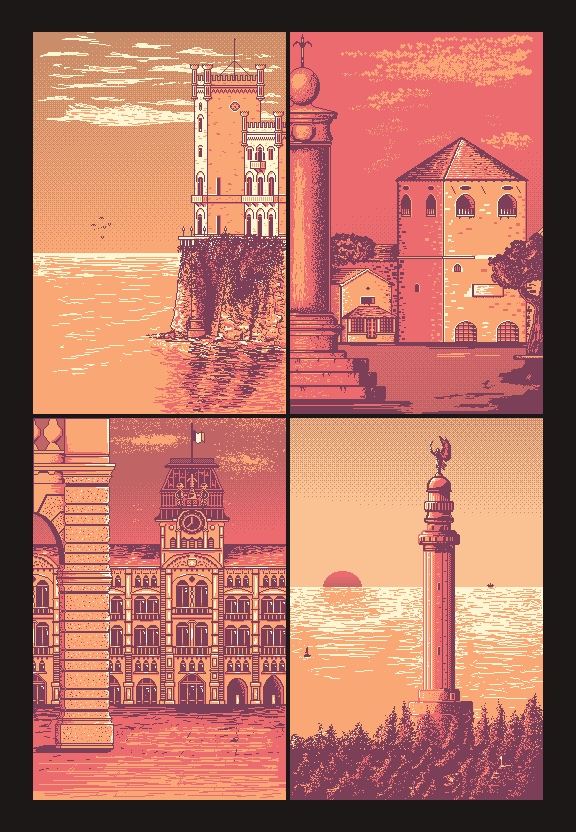by Edward Hunt
To an international audience, Trieste remains among the lesson-known Italian cities. Despite continually scoring highly among Italians for quality of life, it lacks a particularly well-known monument or event. From the perspective of its inhabitants, this is arguably a good thing as it prevents continued influx of massive tourist crowds. But it might also give the impression that the city has little history or has not seen anything of interest. In fact, Trieste is situated in a zone that has seen a lot of movement, sometimes not in a good way.
Despite several period of relative independence, it has usually been grabbed by one and then another local power. Hence this modern perspective that it is a lovely place but lacks a unique selling point may be a core reason behind Trieste survival for so long in relative prosperity, rather than being periodically assaulted and destroyed.
Trieste, suitably enough, seems to have been founded by a mixed group of cultures coming up from the Adriatic coast and down from the mountains. The utility of a coast, hills and woods is quite clear to anyone looking for a potentially prosperous settlement. But this does not seem to have been a structured effort, more the town drawing in greater numbers as the economy grew.
The movement of the coastline, damage to Aquileia, growth of Venice and apparent lack of Byzantine interest allowed Trieste to creep along as a valuable but not core part of the regional economy. During this period, it again became a free city, which arguably it had always been in spirit if not in reality. Concurrent development of a successful economy and efficient local government finally lead to the elders deciding that they had had quite enough of Venician condescension but that Austrian suzerainty might prove a better bet. Not, perhaps, universally popular, but with the absence of Aquileia as a rival and the new power of Austria behind it, Trieste regained is old clout and became the Empire’s largest port. Again, Trieste had managed to walk a delicate middle ground between becoming too valuable to be a casus belli, but enough of a possession to be prized and hence defended.
This decision largely set the stage for Trieste’s modern history. Once again, a polyglot city of utility but not crowning importance, it was taken under the wing of a larger power. Austria-Hungary certainly enjoyed the possession and with no rival powers in the region, the free port could enjoy stability. Despite some back and forth around the time of Napoleon endless interfering, the city was rapidly back under Austrian rule and by the early decades of the 19th Century again enjoying its status.
Trieste was also blessed by the rising tide of new European scholarship, with these decades setting it on a path towards global renown for research and technical development. Unfortunately, the relative regional stability began to invert during the mid-to-late 19th Century. Trieste’s greater value elevated it to the status of regional prize. The Italian annexation of Friuli, Austria’s tottering status, a new distaste for mixed populations all coupled with a valuable port city generated storm clouds on the horizon.
The last century path’s from Austrian to Italian to Military Government then back to Italian is relatively well know. Despite being part of Austria-Hungary, the city was generally supportive of the Italian effort and though some elements of civil war did occur, the arrival of Italian forces in late 1918 seemed to cement the city as part of that country so difficult questions about loyalty could be conveniently buried. Possession was a boon for Italy and the city’s growth continued, though the dark tide of fascism was clearly the price to pay for support from Rome. However, even as Europe crumbled around it, Trieste once again managed to side-step disaster: not important enough to bomb or assault but valuable enough to capture intact
Despite Churchill’s famous phrase, no iron curtain rails have actually been discovered in Trieste. Determining who should own the city again became a post-war diplomatic question. But while it was obviously ‘nice to have’, it was no Berlin or Vienna. Tito had the Adriatic coastline while Italy regained a semi-independent but effective port. Trieste could look down on Aquileia (destroyed), Venice (essentially now a theme-park) and Udine (good football, but less interesting), while returning to its role as a profitable transit zone and cross-roads. Trieste in 2023 is therefore back in its comfortable position as an attractive place to live, home of light industry and scholarship, the end of the transit routes from Asia but not simply the capital of coffee culture. Being big enough to thrive but not a target of envy continues to serve the city very well.





























